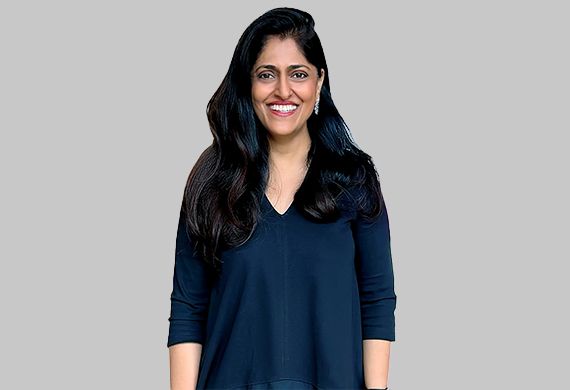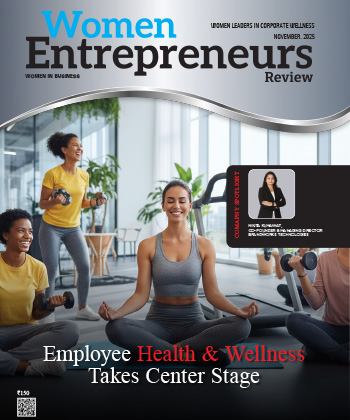
From Market Strategy to Meaningful Impact: Redefining Supportive Leadership in Luxury
By: Richa Singh, Managing Director India & Middle East, Natural Diamond Council
With over 27 years of experience, Richa Singh is a change-maker, who is refining the luxury for today’s consumer. She has successfully led businesses across B2B, B2C, and the Luxury landscape. This has provided her with an in-depth understanding, not only branding but most importantly about consumers - their needs and changing preferences. She made the ‘Natural Diamond Dream’ a reality in India, redefining mindsets toward sustainable, ethically sourced luxury.
In a conversation with Women Entrepreneurs Review Magazine, Richa explores the impact of a support system and right metal approach to design efficiency and growth within the diamond and luxury industry. Driven by accountability, she is committed to crafting policies that empower women to navigate their choices effectively and with confidence.
Is there a shift in how leadership roles are incorporating empathy and flexibility as competitive advantages in the luxury goods and jewellery industry?
Diamonds hold deep emotional significance — they celebrate life’s most meaningful moments and bring lasting joy. To create and communicate such emotionally resonant experiences, we believe it must start from within. That’s why we prioritise empathy and flexibility as foundational values, knowing they shape the mindset, atmosphere, and ultimately the quality of our work
We are a dedicated team of women who have the autonomy to pursue our vision. For any woman to grow in the corporate world, a robust support system is essential. Success in the industry requires a network of people standing behind you and work alongside to achieve the end goals. We create an environment that fosters open communication and freedom of expression that empowers the team. This in-turn enablesthem to operate with confidence, leverage the best of the company’s resources and contribute their best in turn.
Flexible work environments often come with invisible trade-offs, such as the risk of blurred boundaries between work and life. How do you address these subtle challenges?
Maintaining work-life balance is a delicate process, especially without a strictly defined structure. Ultimately, it depends on the individual, their professional role and responsibilities and the opportunities they can leverage. For women, maintaining thisbalance isdifficult but manageable when presented with autonomy to navigate and structure their roles effectively.
Prioritizing responsibilities becomes a natural process and develops with experience, making it easier to execute for senior team members compared to those who are earlier in their careers. We provide professionals to voice their concerns, allowing for feasible alternatives to be explored. A successful professional environment recognizes and values diverse working styles. Personal commitmentsare of equal importance, therefore, open communication in the workplace is essential for fostering a transparent and inclusive work culture. In-person interactions at the office play a crucial role in learning and professional growth.
Operating across regions like India and the Middle East, how do balance between traditional societal roles and modern leadership expectations in shaping policies that truly empower women?
While modern leadership principles drive progress globally, the real challenge lies in designing policies that effectively support women, especially given the cultural expectations they navigate. In the context of India presenting unique dynamics. Today, as society increasingly encourages women to pursue their careers, true empowerment comes from supporting them in balancing professional ambitions with their responsibilities at home.
We must collectively, foster an environment that empowers women to make confident and informed decisions, free from the fear of judgement. Gaining insights from experiences and establishing our own expertise is essential. I believe in the principle of doing good and receiving good and firmly advocate for leading by example and staying true to my vision.
As a leader, my role is to instil confidence in my team and equip them with the tools they need to make informed decisions. This requires strategic planning and the ability to balance both personal and professional priorities to maintain clarity and efficiency.
While flexibility is empowering, it can lead to employees feeling like they must prove their productivity outside traditional hours. How do you recognize and manage such tendencies to avoid undermining the purpose of flexibility?
An effective leader requires to identify various dynamics and implement strategies to maintain accountability resulting in trust and productivity. Performance based evaluations, clear expectations, helps to ensure that flexibility benefits for both employees and organization. As a team what matters is the quality of output rather the number of hours worked. While KPIs are designed to align with standard work hours, success is driven by confidence and accountability. Employees should feel trusted to manage their responsibilities without micromanagement.
A gradual shift is observed in the mindset of women, where office hours are based on choice, work load and flexibility. Our team consists of responsible professionals who do not micromanage time, as performance is measured by outcomes and not by time spent. As working professionals, we invest in spending quality work time, making our team an integral part of our lives. Striking the balance is the key, as I provide my team with opportunities and accountability. Setting transparent and realistic expectations is what matters the most.
How do you reshape the perception of these workplaces to one that celebrates personal fulfilment, without risking the prestige and exclusivity associated with the luxury industry?
Our approach is not confined to a specific industry or luxury brand but is driven by a work style that is forward-thinking. Some industries do come with inherent challenge, but our industry’s distinct advantage lies in anticipating emerging luxuries before they gain mainstream traction. Our focus is on predicting what the consumer will desire, not just fulfilling necessities. We encourage a culture of lateral thinking and innovation, allowing our team the creative freedom to explore new ideas. We prioritize to create an environment that fosters forward-thinking. In the luxury sector, attention to detail and highest standards of quality are fundamental to success.
Every company has its unique nuances and a distinct approach to their work. Luxury is not necessarily tougher than mass markets or other categories, it’s about the spirit of creation and execution that matters the most. We uphold an unspoken rule, that if someone is unavailable, someone else steps up to ensure continuity.A strong collaborative environment results from team work where success and failure both are shared. While individuals have a role to play, building a brand depends on the strength of the team.
The luxury sector is known for setting trends, but have you drawn inspiration from other industries that excel in integrating personal well-being with professional excellence?
As a smaller company, we cannot always offer what a larger firm does, but we provide personalised solutions. Without rigid policies, we adapt to individual’s needs. Our key learning, particularly after lockdown, was flexibility-supporting each other through highs and lows.
Challenges can arise from personal, professional, or external factors, but a strong culture of support keeps us moving forward. I prioritized one key principle-ensuring everyone aligns with a common goal, driving success for all. Focusing on specific roles can make teams lose sight of the bigger vision. Every function contributes to the end goal, and leaders must ensure that their teams understand and align with it. While creating KPIs is essential, encouraging out-of-the-box thinking is largely encouraged and required.I believe that flexibility allows us to explore new ideas and work around an approach inspired by agile start-ups and big corporations. Open platforms for sharing bold ideas should be encouraged.
Most Viewed
- 1 Women's Health Startup HerMD Closing Doors Amid Industry Challenges
- 2 5 Famous Women in Indian Armed Forces
- 3 Saudi Women No longer Require Male Permission for Clothing Choices, says Prince MbS
- 4 Kolkata Medtech Startup Innovodigm Raises Rs 5.5 Crore Seed Funding Led by IAN Group
- 5 Yamunanagar's Kashish Kalra Honoured after Securing 111th Rank in UPSC Civil Services Exam
- 6 Madurai Appoints Its First Woman Corporation Head
- 7 IAS Vijayalakshmi Bidari Appointed as the new Nagpur Divisional Commissioner
- 8 American Entrepreneur Lucy Guo Overtakes T Swift to become Youngest Female Billionaire
- 9 ICC Women's World Cup 2025 Trophy Showcased at Indore's Holkar Stadium
- 10 Aparna Saxena's Beauty Venture AntiNorm Launches in India
- 11 Vidya Nataraj Co-Founded BlueStone Jewellery & Lifestyle files IPO
- 12 5 Women Freedom Fighters of India
- 13 Dr. G Krishnapriya appointed as CEO for Trichy
- 14 M3M & Sirona Partner to Introduce Menstrual Hygiene Vending Machines in 15 Locations
- 15 Punjab Govt launches SHE Cohort 3.0 Supporting Tech-led Women Startups
- 16 Indian origin Lawyer, Sweena Pannu appointed as the US New Superior Court Judge
- 17 The Aurora Tech Award recognizes 4 Indian Women-led Startups
- 18 Kerala's Republic Day parade featured an all-female tableau
- 19 Manisha Kabbur Becomes Karnataka's First Woman International Karate Coach
- 20 Director K. S. Ravikumar's Daughter Maalica Ravikumar Launches Life Coaching Company 'Evergrowth Academy' for Women
- 21 Leezu's Raises Pre-Seed Funding to Accelerate Growth in Sexual Wellness Industry
- 22 Sattu: Super-easy summer drink for PCOS gut healing
- 23 Swathi Nelabhatla creates Sitha App, India's First Women-Exclusive Gig Platform
- 24 7 Timeless Female Kathak Dancers & their Iconic Legacies
- 25 Meet 7 Iconic Women Architects of Modern India & their Most Impactful Work
- 26 This Woman-led Insuretech Startup is Helping Bridge the Education Financing Gap in India
- 27 Women Leaders Share Lessons Learnt from India Women's WC Win
- 28 5 Enterprising Women Founders Powering Singapore's Tech & Innovation Landscape
- 29 4 Women. 4 Stories. One Vision for Smarter, Stronger Healthcare
- 30 Global Gender Gap Narrows to 68.8%, But Full Equality 123 Years Away: WEF Report 2025
- 31 Changemakers: 7 Women Entrepreneurs Taking the Make in India Movement Forward
- 32 Meet Lucy Guo, The Youngest Self-Made Female Billionaire Disrupting Tech
- 33 How Women are Driving India's Festive Online Shopping Surge






